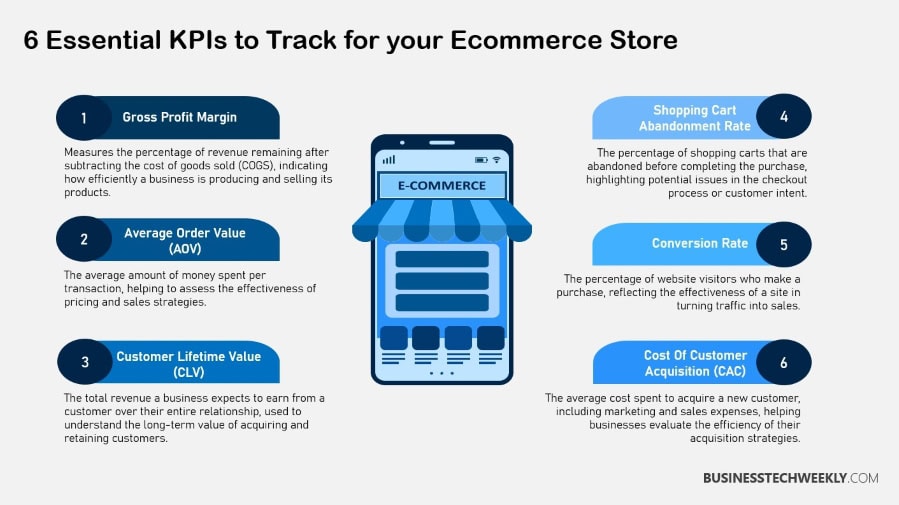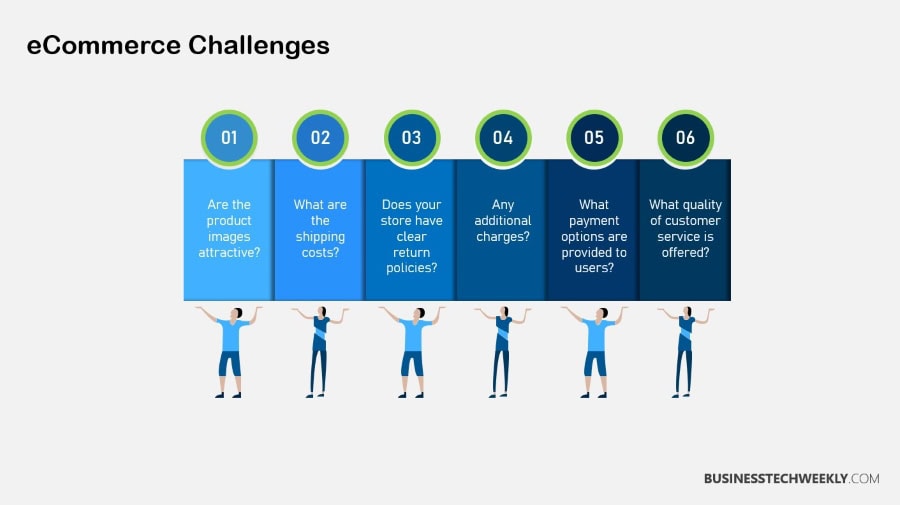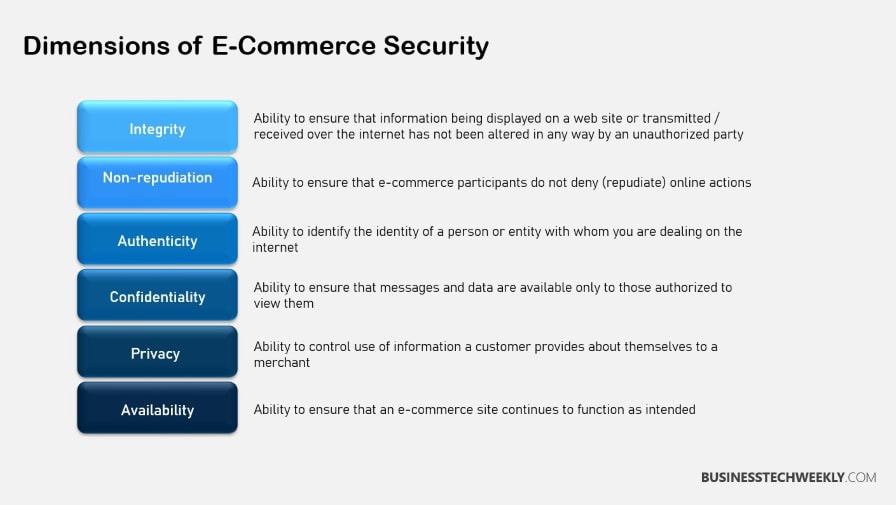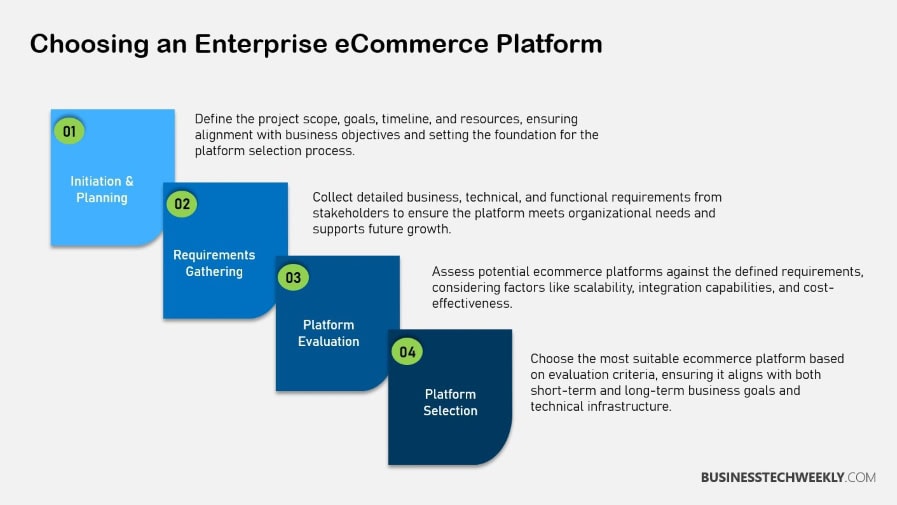Enterprise eCommerce Platforms: Scaling your Business

On this page:
- Importance of Choosing the Right Platform
- Types of Enterprise eCommerce Platforms
- Key Features for Scalability and Security
- Integration Capabilities in eCommerce Solutions
- Steps to Migrate to a New Platform
- How to Choose the Right Enterprise eCommerce Platform
- Understanding Costs of Enterprise Platforms
- Key Takeaways
- Frequently Asked Questions
Importance of Choosing the Right Platform
With a range of eCommerce platforms to choose from, selecting the right solution is a major decision for your business. The right platform makes your business run smoother and helps you sell more.
Now imagine if you had a system that eliminated inventory costs and automatically followed up with customers for you. A strong platform also retains customers by keeping shopping on the platform simple and engaging.
It even provides you with better data insights to make smart decisions.
1. Impact on Business Success
A well-chosen platform ramps up your business efficiency. With this training, you can process orders on the fly and efficiently manage stock. Plus, you’ll know which products you’ll need more of down the line. This increases sales growth.
Have a customer who you know loves your brand?
A good platform keeps them coming back by smoothing out the kinks in their shopping experience. You’ll glean important insights into your customers’ preferences so you can better serve them.
Track important KPIs like page load speed, conversion rates, customer retention rates and average order value to gauge how your platform is contributing.
2. Enhancing Customer Experience
Your eCommerce platform needs to make shopping easy and personal. Features such as personalized recommendations and easy navigation help customers feel appreciated and understood.
Allow customer feedback to inform adjustments to your platform so that it’s tailored to their needs.
Don’t forget mobile optimization—it’s key for today’s on-the-go shoppers. Make your platform easy to use on phones and tablets.
Here’s a checklist: fast loading times, user-friendly design, and an easy checkout process are must-haves for any enterprise eCommerce platform.
RELATED: Building an Omnichannel Strategy for Seamless Customer Experience
3. Optimizing Operational Costs
Identify automation features to reduce labor costs by processing orders or answering customer queries. This optimization means you spend less on staffing. More efficient inventory management saves further money through less overstock.
Watch out for transaction fees; in some cases, they can be a money drain. Compare the costs of each platform, including things like subscription fees and transaction charges.
Keep in mind that a SaaS solution may not provide all the custom features you need.

Types of Enterprise eCommerce Platforms
Shopping for the best enterprise ecommerce solution is akin to navigating a bustling market. You’ll encounter a variety of modern enterprise ecommerce platforms, each offering a unique twist.
Let’s explore some of the most popular ecommerce platforms available today.
SaaS Platforms
Software as a Service (SaaS) platforms essentially give you an already built solution. They are super simple to set up and scale!
Think about when you rent a fully furnished apartment. You get regular updates and maintenance, all included in your monthly fee.
This pricing model also means that you can budget without worrying about surprise costs. SaaS platforms such as Shopify, launched in 2006, give you all the advantages of a modern platform. You can do all this without having to worry about technical upkeep.
Here’s a snapshot comparison:
|
Platform |
Key Features |
|---|---|
|
User-friendly, extensive app store |
|
|
BigCommerce |
Scalability, robust security |
|
WooCommerce |
Flexibility, open-source nature |
Headless Commerce Systems
Headless commerce systems provide the flexibility of a tailored suit, allowing you to craft custom customer journeys. By separating the front end from the back end, integrating third-party services and APIs can be done easily.
This helps your site load faster and provide better performance. Industries like fashion and tech thrive on this arrangement where creativity is paramount.
These systems prevent you from falling victim to antiquated, unwieldy technology and provide you with a more contemporary method for designing a website.
- Fashion
- Technology
- Retail
Composable Technology Stacks
Imagine building your dream house brick by brick; that’s exactly what composable technology stacks enable. They allow you to customize every aspect of your eCommerce set-up, choosing the best solution for every function.
This setup significantly accelerates innovation. You can easily swap out modules as needed, like AI engines or low-code systems, to keep your business ahead of the curve.
Here’s what to consider when building:
- Customer Management System
- Payment Gateway
- Analytics Tools
Open Source Solutions
Open-source enterprise eCommerce platforms offer cost-effectiveness and flexibility unmatched by proprietary platforms, allowing you to tweak and customize to your heart’s content.
Communities around these platforms, like Magento or WordPress, have tons of resources to train you in the process.
Here are some popular platforms:
- Magento: Highly customizable, strong community support
- WooCommerce: Seamless WordPress integration, extensive plugins

Key Features for Scalability and Security
Scalability Essentials
Your business is booming, and suddenly, your eCommerce platform crumbles under the pressure of increased traffic. You don’t want that, right?
That’s where scalability comes in. A scalable platform manages spikes of traffic and sales, particularly during peak times, such as end-of-year sales or limited-time offers.
Consider flexible price plans as well. You want something that scales with your business without costing an arm and a leg.
Take Shopify Plus, for example. It’s a SaaS platform that scales with you, giving you a smooth ride as your business takes off. It’s affordable, with the lowest platform cost of any competitor by 23%.
However, its customization options do have their limits. If you want to be able to add certain new features or integrations, make sure the platform accommodates these without making things bumpy. To track scalability, monitor indicators such as server response time, load capacity, and uptime percentages.
These metrics help you ensure your platform grows without a hitch.
Security Considerations
Security is non-negotiable in the eCommerce industry. It’s like the guard at the gate of your enterprise ecommerce business. Seek out top enterprise ecommerce platforms with strong security features, including encryption and secure payment gateways, to protect customer data.
A platform that adheres to regulations such as GDPR and PCI DSS is crucial, ensuring your operations comply with the law.
Powerful enterprise eCommerce platforms, like Shopify Plus, bundles security and PCI compliance into its package, allowing you to focus on business growth.
Create a security checklist: verify encryption standards, confirm compliance certifications, and ensure robust fraud protection measures are in place to safeguard your enterprise ecommerce system.
RELATED: PCI DSS: Requirements of the Payment Card Industry Data Security Standard
Advanced analytics and reporting features are commonly available in enterprise ecommerce platforms, empowering businesses to make data-driven decisions. These tools provide insights into sales performance, customer behavior, and inventory levels, facilitating informed strategic planning.
Integration Capabilities in eCommerce Solutions
Seamless Integration Benefits
Just imagine how smoothly your business would run if all your systems communicated perfectly. Imagine how much more time and creativity you would have on a daily basis!
Seamless integration with existing business tools isn’t just about convenience; it’s about creating a symphony of operational harmony.
Consider the difference when your eCommerce platform talks seamlessly to logistics providers, partner systems, and beyond. Not long ago, integrating these services came with high costs and significant risks.
Today’s technology has changed all that, making the process easier and safer.
A single view of customer data is like a crystal ball. It lets you tailor interactions, making your customers feel appreciated and understood.
Take advantage of built-in marketing features to generate sales. Hit your customers with the right message at the right time.
Real-time data sharing is essential as it keeps you from taking actions based on the news of yesterday, instead of the news of today.
Here’s a quick look at what you might consider integrating into your platform:
- CRM systems for managing customer relationships
- ERP systems for business process management
- Analytics tools for tracking performance
- Localization services, since 40% of customers won’t buy if a site isn’t localized.
Don’t forget, with solutions such as OCC, integration with other Oracle products and third-party systems is straightforward.
Tools and Technologies
In the realm of eCommerce, tools and tech help you run a tight ship, supporting your strategy and boosting efficiency. CRM and ERP software are the critical underpinnings of this, so it’s possible that you’re even ahead of the game already.
Analytics tools are indispensable, giving you insights into customer behavior and allowing you to track performance.
When reviewing enterprise eCommerce platforms, consider these must-have tools:
- AI engines for predictive analysis
- Low-code systems for business process design
- Third-party solutions that can replace any module if needed.
These tools ensure your platform isn’t just surviving but thriving.
A truly perfect enterprise eCommerce solution should be flexible enough to incorporate any third-party innovations, no matter what the future holds.

Steps to Migrate to a New Platform
Migrating to a new enterprise ecommerce platform can be overwhelming; ensuring everything runs smoothly requires following these key steps for a successful transition to a powerful ecommerce solution.
Assess Business Needs
Take a hard look at your current eCommerce setup. Are there concerns for you or your customers? There may be a glitchy checkout process or slow load times. Write those down.
Then consider what you want your business to accomplish. Do you want to go global or get more loyal customers?
Your platform needs to align with these goals. Understanding your customers is key. What do they enjoy? How do they shop?
Here’s a quick list of questions to guide you:
- What are my current platform’s limitations?
- What features do I need to achieve my business goals?
- How do my customers interact with my site?
Conduct Thorough Research
Next, dig in and do some research. Look at various enterprise eCommerce platforms, compare the features and the price. Then look at user reviews and in-depth case studies to see how others have fared.
Attend webinars or product demos to get a sense of how the platforms work. This isn’t simply window shopping. Create a table to note your findings. That way, you’ll have a good idea of what each platform offers.
Plan the Migration Process
Planning is your best friend here. Put together a migration plan that outlines timelines and who’s doing what. To mitigate risks such as data loss, have backup plans in place.
Talk your plan through with everyone involved to get them on the same page.
To keep things on track, list key milestones such as:
- Completion of data migration
- Successful testing of new platform
- Final launch date
Execute Data Migration
Data is gold — treat it well. Ensure that all of your customer and product data transfers to the new platform properly. Validate the data after migration to catch any errors early.
Back up your information before you begin so you won’t lose anything valuable. Here’s a checklist for data types to migrate:
- Customer accounts
- Orders
- Inventory
Test and Troubleshoot
Before you go live, test the new platform thoroughly. That’s like a dress rehearsal. Get your team involved to catch different perspectives. If issues arise, fix them immediately.
Make a list of scenarios to test, including:
- Page load times
- Mobile responsiveness
- Checkout process
Launch and Monitor Progress
Finally, engineer your launch to capture attention. Monitor important metrics such as website visits and user interaction. Keep collecting feedback from customers to improve your platform.
In the first month, take actions such as:
- Monitoring organic traffic
- Checking search rankings
- Optimizing new content with keywords

How to Choose the Right Enterprise eCommerce Platform
Choosing the right enterprise eCommerce solution isn’t as simple as picking a name off a list. It’s crucial to consider what’s necessary for your business. Concentrate on scalability, flexibility, and how well modern enterprise eCommerce platforms align with your goals.
First, figure out what’s most important to you. Do you want a powerful eCommerce solution that can scale with you over the next three to five years? Factor in the total cost, including implementation and operational fees, to ensure it fits your budget.
Evaluate how easily you can import existing data and integrate with your current ERP and CRM systems. It must conform to your needs as the enterprise eCommerce system. This is especially essential when you have a lot of traffic and a large sales volume.
Security features are a must, so check if the platform supports payment gateways and complies with PCI DSS standards.
Evaluate Business Size and Sales Volume
For smaller businesses, you may need a platform that has basic features but can grow as you grow. If you’re a larger operation with high sales volume, you will need features to back it up.
Consider how your sales volume impacts what you need. Heavy sales may require more advanced inventory management or customer service features. Growth potential is another factor. Are you planning a major expansion? Make sure the platform can handle it.
Here’s a simple table to consider:
|
Business Size |
Platform Option |
Sales Volume |
|---|---|---|
|
Small |
Low |
|
|
Medium |
Magento |
Medium |
|
Large |
Salesforce |
High |
Consider International Expansion Plans
If you’re looking at international markets, your platform must be able to support that vision. Multilingual and multi-currency features aren’t just nice-to-haves; they’re necessities.
Compliance with international laws is essential as well. Look for platforms that offer these features:
- Multilingual support
- Multi-currency handling
- International compliance
- Global shipping options
Assess In-House Technical Skills
How you run your platform will depend on your team’s technical skills. If you have a tech-savvy team, a complex platform might be fine. If not, you’re going to want something easy to use.
Look for training programs that will allow your team to hit the ground running.
Here’s a checklist to guide you:
- Basic coding knowledge
- Understanding of platform management tools
- Access to training resources
- Ability to troubleshoot basic issues
Determine Customization Requirements
Your business is unique, and so are your needs. If customization is essential, look into platforms with flexibility. Remember, customization comes with a price.
Here’s a list of features to think about:
- Custom checkout processes
- Unique user interfaces
- Integration with custom apps
- API access for further development
Align with Long-Term Goals
Your platform should sync with your big-picture goals. It’s not about today; it’s where you want to be in the future. Assess how each option can adjust to market trends and shifts.
Scalability is key, so it can keep up with your growth. Compare platforms based on how well they align with your long-term vision.
In 2023, WooCommerce led the global e-commerce software market with a 39% share, followed by Squarespace Online Stores at 14.95% and Woo Themes at 14.67%.
Understanding Costs of Enterprise Platforms
If you’re considering modern enterprise eCommerce platforms, understanding the cost components is crucial. It’s time to go deep here because it’s so important. You’re not just looking at the upfront setup fee; there’s a veritable cornucopia of costs involved in selecting the right enterprise ecommerce solution.
Planning a big event involves some thought. You have to think about the venue, the catering, the entertainment, and even those cool little party favors. Similarly, for platforms, you have to account for licensing fees and the costs of integrating third-party tools.
Maintenance costs can sneak up on you like an unwanted visitor, especially with enterprise eCommerce platforms. While licensing may seem straightforward initially, adding optional features can significantly swell your budget, making it vital to evaluate your enterprise commerce options carefully.
Budgeting for Software Solutions
Before you even begin to pick out a platform, you have to evaluate your overall budget. Consider everything from software to ongoing maintenance. Think of it as a checklist to keep your finances in check.
Here’s a quick bullet list of what to keep in mind:
- Initial setup and licensing fees
- Design and development costs can be between £100,000 and £5,000,000.
- Ongoing maintenance and updates
- Integration with third-party systems and potential hidden costs
- Contingency funds for unexpected expenses
Remember, it’s like buying a house – you don’t pay just for the house; there are utilities, taxes, and unforeseen repairs to account for.
Analyzing Cost Factors
Understanding what costs the most helps steer your decision. Subscription costs, transaction fees, and other features come into play. It’s important to look at the Total Cost of Ownership (TCO) across platforms.
One platform may be less expensive upfront; another may deliver much better long-term value. For example, if a platform has high transaction fees, it may eat into your profits over time.
To assist with decision-making, summarize the cost factors for different platforms in a table. This provides a clear view of the financial landscape, so you don’t miss any critical detail. Think of this as your roadmap for financial planning in the eCommerce jungle.
Key Takeaways
- The right enterprise eCommerce platform could make all the difference for your business. It can directly affect your scalability, security, and customer experience.
- Many types of enterprise eCommerce solutions are available, each with features that cater to different business needs. Knowing these can aid in making a conscious decision.
- Platforms must have key features like scalability and robust security. These are essential to accommodate growth and protect your business and customers’ data.
- Integration capabilities are essential for seamless operation. Make sure the platform you select can seamlessly integrate with your current systems and third-party applications.
- Moving to a new platform is a process that must be executed strategically. Planning and testing are needed to limit disruptions and make the changeover go smoothly.
- Know the costs behind enterprise platforms. Look for upfront costs and long-term expenses to make sure the platform works within your budget and has the features you need.
Frequently Asked Questions
Why is choosing the right eCommerce platform important?
Ensure you select a capable enterprise ecommerce platform that is scalable, secure, and can seamlessly integrate with other tools. This choice enables business expansion, safeguards confidential data, and enhances customer experience, ultimately boosting sales and brand loyalty.
What are the key features to look for in an enterprise eCommerce solution?
Key features of a top enterprise ecommerce platform may include scalability, robust security measures, integration capabilities, and user-friendly interfaces, ensuring the platform can grow with your enterprise business and provide a seamless shopping experience.
How can integration capabilities benefit an eCommerce business?
Integration capabilities of modern enterprise ecommerce platforms connect seamlessly with third-party services such as payment gateways, CRM systems, and analytics tools, simplifying operations and enhancing the customer experience.
What steps should be taken when migrating to a new eCommerce platform?
Start with a plan that is a little bit more extensive. Evaluate existing data, test compatibility of modern enterprise ecommerce platforms, and minimize downtime during migration. That way, there’s no interruption to enterprise ecommerce business while making a transition.
How do you determine the cost of an enterprise eCommerce platform?
Costs vary based on features, customization, and support when evaluating modern enterprise ecommerce platforms. Weigh your budget against each platform’s capabilities, scalability, and long-term value based on your specific business needs and goals.
What factors should be considered when choosing the right eCommerce platform?
Look for scalability, security, integration capabilities, and cost in a capable enterprise ecommerce platform. These factors will ensure the platform supports growth, protects data, and fits your budget.

